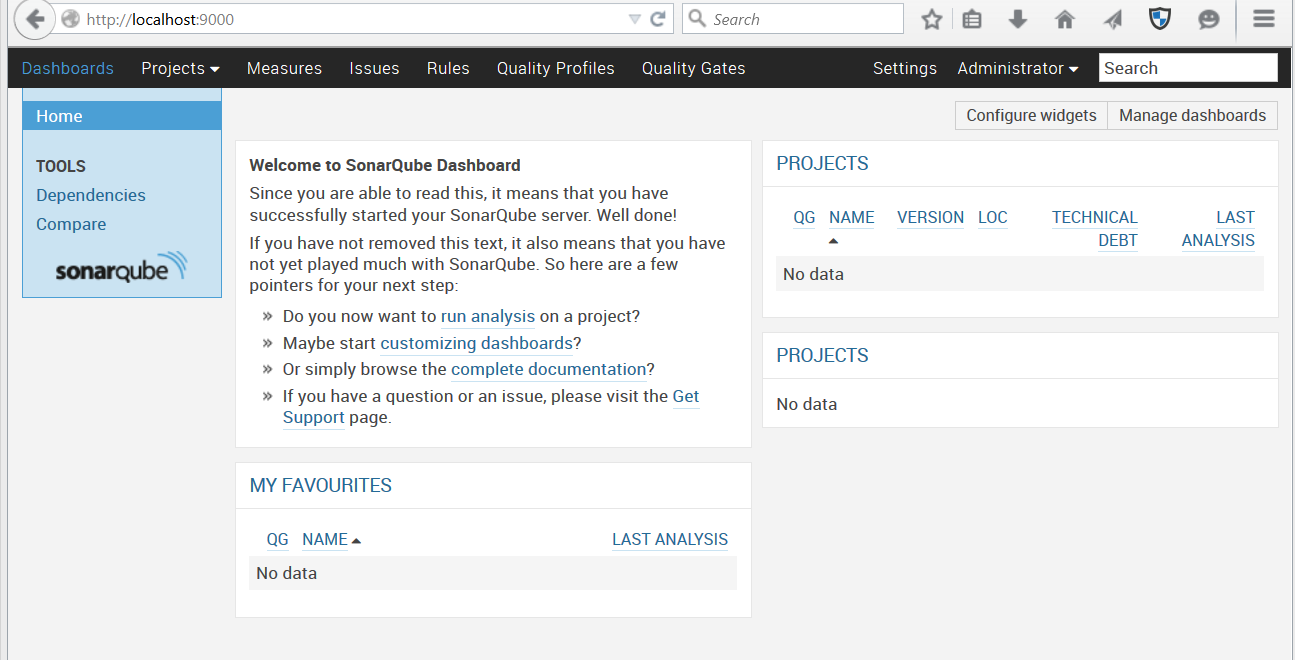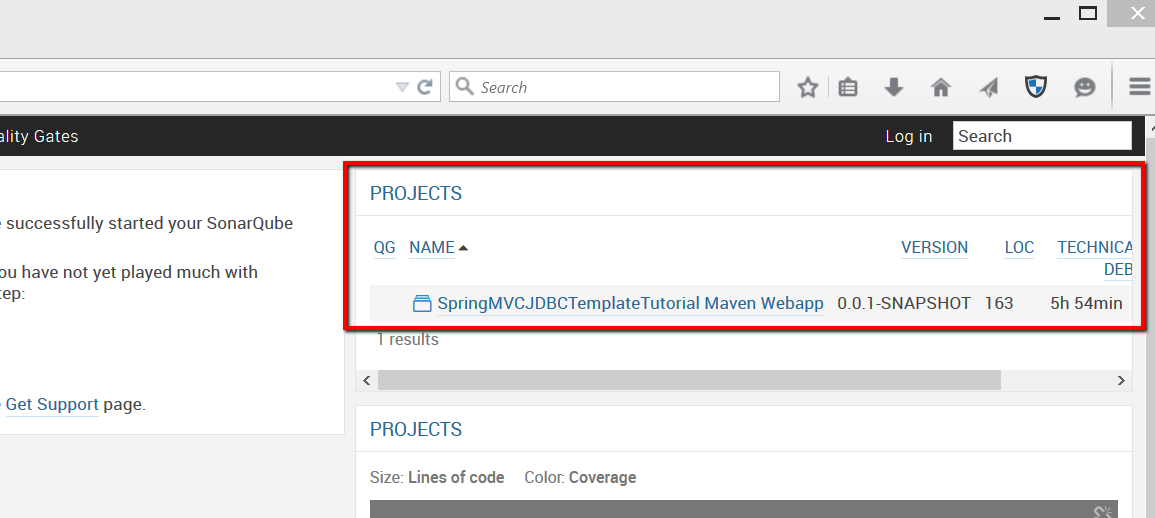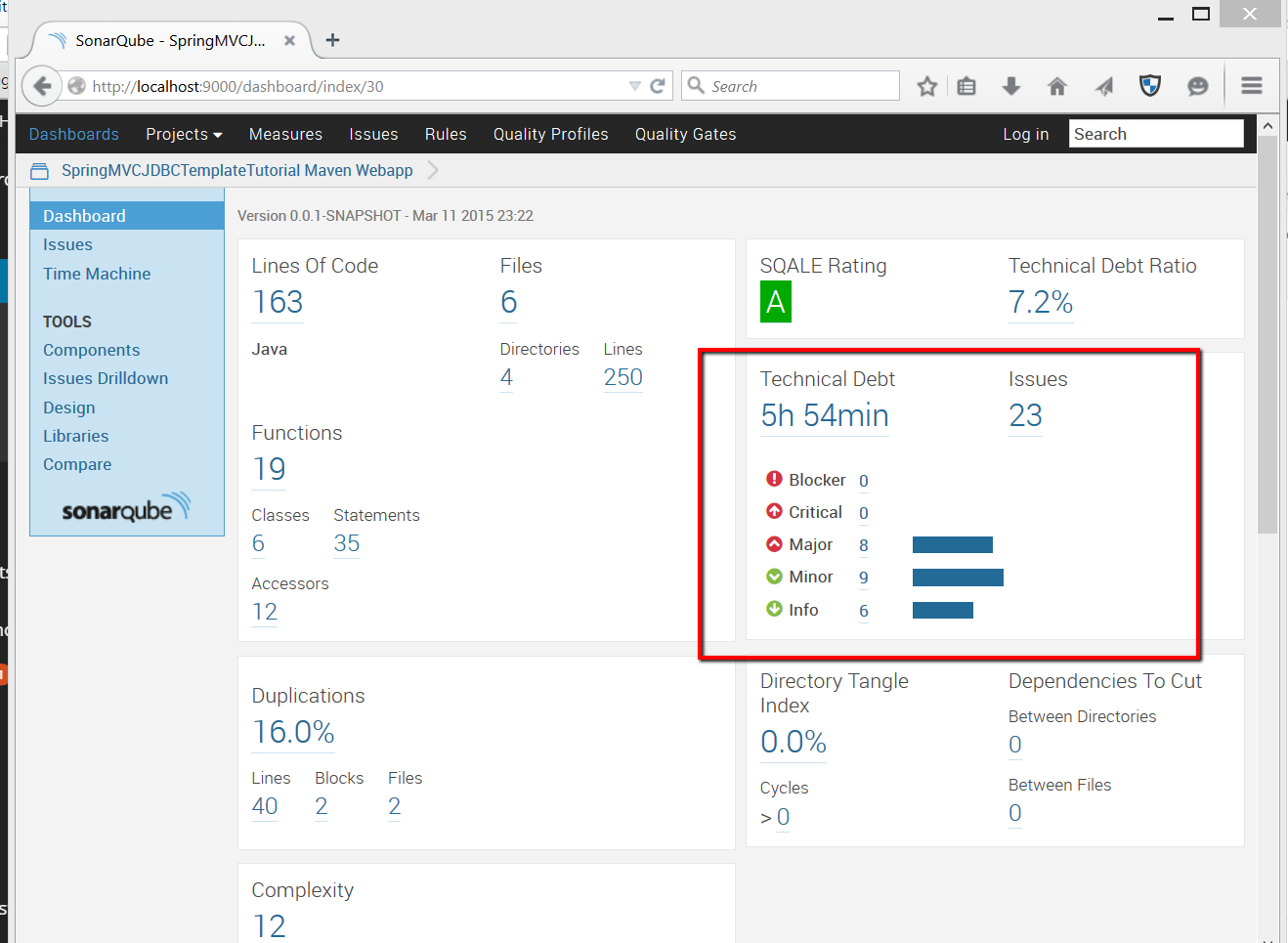Add New Project Sonar
To keep continue inspection of the code quality Sonar is right tool. It can generate report of coding standard, complexity of the code, potential bugs, unit tests, duplicated code etc…In this demo I will show you how to configure project with Sonar so that we can see generated report. Please follow steps below:
- First install and start sonar using this tutorial
- Once Sonar is started you can use its default host and port http://localhost:9000/ to open its console which will look below if no project is configured:
- Important thing to note: You won’t find any option to add new project to Sonar from its console. You have to start analysis process, if its done successfully then project will be added automatically to Sonar where you can see its report. There are many ways you could analyze your project and in this tutorial we will be analyzing maven java project.
- Prerequisites: You have installed and configured maven on your local system. If you have not configured yet please follow this tutorial. For test I have attached one sample maven spring based project which you can download and use for analyzing.
- Before running maven goal you will have to add below profile setting in maven settings.xml file whose default location is: $MAVEN_HOME/conf or C:\Users\User_name\.m2 directory.
<settings>
<profiles>
<profile>
<id>sonar</id>
<activation>
<activeByDefault>true</activeByDefault>
</activation>
<properties>
<!-- Example for MySQL-->
<sonar.jdbc.url>
jdbc:mysql://localhost:3306/sonar?useUnicode=true&characterEncoding=utf8
</sonar.jdbc.url>
<sonar.jdbc.username>sonar</sonar.jdbc.username>
<sonar.jdbc.password>sonar</sonar.jdbc.password>
<!-- Optional URL to server. Default value is http://localhost:9000 -->
<sonar.host.url>
http://myserver:9000
</sonar.host.url>
</properties>
</profile>
</profiles>
</settings>- Below is complete settings.xml file with default configuration:
<?xml version="1.0" encoding="UTF-8"?>
<!--
Licensed to the Apache Software Foundation (ASF) under one
or more contributor license agreements. See the NOTICE file
distributed with this work for additional information
regarding copyright ownership. The ASF licenses this file
to you under the Apache License, Version 2.0 (the
"License"); you may not use this file except in compliance
with the License. You may obtain a copy of the License at
http://www.apache.org/licenses/LICENSE-2.0
Unless required by applicable law or agreed to in writing,
software distributed under the License is distributed on an
"AS IS" BASIS, WITHOUT WARRANTIES OR CONDITIONS OF ANY
KIND, either express or implied. See the License for the
specific language governing permissions and limitations
under the License.
-->
<!--
| This is the configuration file for Maven. It can be specified at two levels:
|
| 1. User Level. This settings.xml file provides configuration for a single user,
| and is normally provided in ${user.home}/.m2/settings.xml.
|
| NOTE: This location can be overridden with the CLI option:
|
| -s /path/to/user/settings.xml
|
| 2. Global Level. This settings.xml file provides configuration for all Maven
| users on a machine (assuming they're all using the same Maven
| installation). It's normally provided in
| ${maven.home}/conf/settings.xml.
|
| NOTE: This location can be overridden with the CLI option:
|
| -gs /path/to/global/settings.xml
|
| The sections in this sample file are intended to give you a running start at
| getting the most out of your Maven installation. Where appropriate, the default
| values (values used when the setting is not specified) are provided.
|
|-->
<settings xmlns="http://maven.apache.org/SETTINGS/1.0.0"
xmlns:xsi="http://www.w3.org/2001/XMLSchema-instance"
xsi:schemaLocation="http://maven.apache.org/SETTINGS/1.0.0 http://maven.apache.org/xsd/settings-1.0.0.xsd">
<!-- localRepository
| The path to the local repository maven will use to store artifacts.
|
| Default: ${user.home}/.m2/repository
<localRepository>/path/to/local/repo</localRepository>
-->
<localRepository>C:\JavaHonk\repository</localRepository>
<!-- interactiveMode
| This will determine whether maven prompts you when it needs input. If set to false,
| maven will use a sensible default value, perhaps based on some other setting, for
| the parameter in question.
|
| Default: true
<interactiveMode>true</interactiveMode>
-->
<!-- offline
| Determines whether maven should attempt to connect to the network when executing a build.
| This will have an effect on artifact downloads, artifact deployment, and others.
|
| Default: false
<offline>false</offline>
-->
<!-- pluginGroups
| This is a list of additional group identifiers that will be searched when resolving plugins by their prefix, i.e.
| when invoking a command line like "mvn prefix:goal". Maven will automatically add the group identifiers
| "org.apache.maven.plugins" and "org.codehaus.mojo" if these are not already contained in the list.
|-->
<pluginGroups>
<!-- pluginGroup
| Specifies a further group identifier to use for plugin lookup.
<pluginGroup>com.your.plugins</pluginGroup>
-->
</pluginGroups>
<!-- proxies
| This is a list of proxies which can be used on this machine to connect to the network.
| Unless otherwise specified (by system property or command-line switch), the first proxy
| specification in this list marked as active will be used.
|-->
<proxies>
<!-- proxy
| Specification for one proxy, to be used in connecting to the network.
|-->
<!--<proxy>
<id>optional</id>
<active>true</active>
<protocol>http</protocol>
<username>proxyuser</username>
<password>proxypass</password>
<host>proxy.host.net</host>
<port>80</port>
<nonProxyHosts>local.net|some.host.com</nonProxyHosts>
</proxy>-->
</proxies>
<!-- servers
| This is a list of authentication profiles, keyed by the server-id used within the system.
| Authentication profiles can be used whenever maven must make a connection to a remote server.
|-->
<servers>
<!-- server
| Specifies the authentication information to use when connecting to a particular server, identified by
| a unique name within the system (referred to by the 'id' attribute below).
|
| NOTE: You should either specify username/password OR privateKey/passphrase, since these pairings are
| used together.
|
<server>
<id>deploymentRepo</id>
<username>repouser</username>
<password>repopwd</password>
</server>
-->
<!-- Another sample, using keys to authenticate.
<server>
<id>siteServer</id>
<privateKey>/path/to/private/key</privateKey>
<passphrase>optional; leave empty if not used.</passphrase>
</server>
-->
</servers>
<!-- mirrors
| This is a list of mirrors to be used in downloading artifacts from remote repositories.
|
| It works like this: a POM may declare a repository to use in resolving certain artifacts.
| However, this repository may have problems with heavy traffic at times, so people have mirrored
| it to several places.
|
| That repository definition will have a unique id, so we can create a mirror reference for that
| repository, to be used as an alternate download site. The mirror site will be the preferred
| server for that repository.
|-->
<mirrors>
<!-- mirror
| Specifies a repository mirror site to use instead of a given repository. The repository that
| this mirror serves has an ID that matches the mirrorOf element of this mirror. IDs are used
| for inheritance and direct lookup purposes, and must be unique across the set of mirrors.
|
<mirror>
<id>mirrorId</id>
<mirrorOf>repositoryId</mirrorOf>
<name>Human Readable Name for this Mirror.</name>
<url>http://my.repository.com/repo/path</url>
</mirror>
-->
</mirrors>
<!-- profiles
| This is a list of profiles which can be activated in a variety of ways, and which can modify
| the build process. Profiles provided in the settings.xml are intended to provide local machine-
| specific paths and repository locations which allow the build to work in the local environment.
|
| For example, if you have an integration testing plugin - like cactus - that needs to know where
| your Tomcat instance is installed, you can provide a variable here such that the variable is
| dereferenced during the build process to configure the cactus plugin.
|
| As noted above, profiles can be activated in a variety of ways. One way - the activeProfiles
| section of this document (settings.xml) - will be discussed later. Another way essentially
| relies on the detection of a system property, either matching a particular value for the property,
| or merely testing its existence. Profiles can also be activated by JDK version prefix, where a
| value of '1.4' might activate a profile when the build is executed on a JDK version of '1.4.2_07'.
| Finally, the list of active profiles can be specified directly from the command line.
|
| NOTE: For profiles defined in the settings.xml, you are restricted to specifying only artifact
| repositories, plugin repositories, and free-form properties to be used as configuration
| variables for plugins in the POM.
|
|-->
<profiles>
<!-- profile
| Specifies a set of introductions to the build process, to be activated using one or more of the
| mechanisms described above. For inheritance purposes, and to activate profiles via <activatedProfiles/>
| or the command line, profiles have to have an ID that is unique.
|
| An encouraged best practice for profile identification is to use a consistent naming convention
| for profiles, such as 'env-dev', 'env-test', 'env-production', 'user-jdcasey', 'user-brett', etc.
| This will make it more intuitive to understand what the set of introduced profiles is attempting
| to accomplish, particularly when you only have a list of profile id's for debug.
|
| This profile example uses the JDK version to trigger activation, and provides a JDK-specific repo.
<profile>
<id>jdk-1.4</id>
<activation>
<jdk>1.4</jdk>
</activation>
<repositories>
<repository>
<id>jdk14</id>
<name>Repository for JDK 1.4 builds</name>
<url>http://www.myhost.com/maven/jdk14</url>
<layout>default</layout>
<snapshotPolicy>always</snapshotPolicy>
</repository>
</repositories>
</profile>
-->
<!--
| Here is another profile, activated by the system property 'target-env' with a value of 'dev',
| which provides a specific path to the Tomcat instance. To use this, your plugin configuration
| might hypothetically look like:
|
| ...
| <plugin>
| <groupId>org.myco.myplugins</groupId>
| <artifactId>myplugin</artifactId>
|
| <configuration>
| <tomcatLocation>${tomcatPath}</tomcatLocation>
| </configuration>
| </plugin>
| ...
|
| NOTE: If you just wanted to inject this configuration whenever someone set 'target-env' to
| anything, you could just leave off the <value/> inside the activation-property.
|
<profile>
<id>env-dev</id>
<activation>
<property>
<name>target-env</name>
<value>dev</value>
</property>
</activation>
<properties>
<tomcatPath>/path/to/tomcat/instance</tomcatPath>
</properties>
</profile>
-->
<profile>
<id>sonar</id>
<activation>
<activeByDefault>true</activeByDefault>
</activation>
<properties>
<!-- Example for MySQL-->
<!-- Optional URL to server. Default value is http://localhost:9000 -->
<sonar.host.url>
http://localhost:9000
</sonar.host.url>
</properties>
</profile>
</profiles>
<!-- activeProfiles
| List of profiles that are active for all builds.
|
<activeProfiles>
<activeProfile>alwaysActiveProfile</activeProfile>
<activeProfile>anotherAlwaysActiveProfile</activeProfile>
</activeProfiles>
-->
</settings>
- To analyze maven project you will have to run maven goal sonar:sonar in the current directory where pom.xml file is located. Before runing to Sonar goal you will have to run below maven command:
mvn clean install
mvn sonar:sonar
- Go to command line ( I assume you already set path of maven bin directory to the class path) and run below command:

C:\Users\JavaHonk\Downloads\SpringMVCJDBCTemplateTutorial>mvn clean install [INFO] Scanning for projects... [INFO] [INFO] ------------------------------------------------------------------------ [INFO] Building SpringMVCJDBCTemplateTutorial Maven Webapp 0.0.1-SNAPSHOT [INFO] ------------------------------------------------------------------------ [INFO] [INFO] --- maven-clean-plugin:2.5:clean (default-clean) @ SpringMVCJDBCTemplateTutorial --- [INFO] Deleting C:\Users\JavaHonk\Downloads\SpringMVCJDBCTemplateTutorial\target [INFO] [INFO] --- maven-resources-plugin:2.6:resources (default-resources) @ SpringMVCJDBCTemplateTutorial --- [INFO] Using 'UTF-8' encoding to copy filtered resources. [INFO] Copying 3 resources [INFO] [INFO] --- maven-compiler-plugin:3.1:compile (default-compile) @ SpringMVCJDBCTemplateTutorial --- [INFO] Changes detected - recompiling the module! [INFO] Compiling 6 source files to C:\Users\JavaHonk\Downloads\SpringMVCJDBCTemplateTutorial\target\clas ses [INFO] [INFO] --- maven-resources-plugin:2.6:testResources (default-testResources) @ SpringMVCJDBCTemplateT utorial --- [INFO] Using 'UTF-8' encoding to copy filtered resources. [INFO] skip non existing resourceDirectory C:\Users\JavaHonk\Downloads\SpringMVCJDBCTemplateTutorial\src \test\resources [INFO] [INFO] --- maven-compiler-plugin:3.1:testCompile (default-testCompile) @ SpringMVCJDBCTemplateTutori al --- [INFO] Nothing to compile - all classes are up to date [INFO] [INFO] --- maven-surefire-plugin:2.12.4:test (default-test) @ SpringMVCJDBCTemplateTutorial --- [INFO] No tests to run. [INFO] [INFO] --- maven-war-plugin:2.2:war (default-war) @ SpringMVCJDBCTemplateTutorial --- [INFO] Packaging webapp [INFO] Assembling webapp [SpringMVCJDBCTemplateTutorial] in [C:\Users\JavaHonk\Downloads\SpringMVCJDBCTe mplateTutorial\target\SpringMVCJDBCTemplateTutorial] [INFO] Processing war project [INFO] Copying webapp resources [C:\Users\JavaHonk\Downloads\SpringMVCJDBCTemplateTutorial\src\main\weba pp] [INFO] Webapp assembled in [563 msecs] [INFO] Building war: C:\Users\JavaHonk\Downloads\SpringMVCJDBCTemplateTutorial\target\SpringMVCJDBCTempl ateTutorial.war [INFO] WEB-INF\web.xml already added, skipping [INFO] [INFO] --- maven-install-plugin:2.4:install (default-install) @ SpringMVCJDBCTemplateTutorial --- [INFO] Installing C:\Users\JavaHonk\Downloads\SpringMVCJDBCTemplateTutorial\target\SpringMVCJDBCTemplate Tutorial.war to C:\JavaHonk\repository\com\javahonk\SpringMVCJDBCTemplateTutorial\0.0.1-SNAPSHOT\Spr ingMVCJDBCTemplateTutorial-0.0.1-SNAPSHOT.war [INFO] Installing C:\Users\JavaHonk\Downloads\SpringMVCJDBCTemplateTutorial\pom.xml to C:\JavaHonk\repos itory\com\javahonk\SpringMVCJDBCTemplateTutorial\0.0.1-SNAPSHOT\SpringMVCJDBCTemplateTutorial-0.0.1- SNAPSHOT.pom [INFO] ------------------------------------------------------------------------ [INFO] BUILD SUCCESS [INFO] ------------------------------------------------------------------------ [INFO] Total time: 8.782 s [INFO] Finished at: 2015-03-11T23:20:36-04:00 [INFO] Final Memory: 12M/29M [INFO] ------------------------------------------------------------------------
- Once above command got successful please run mvn sonar goal:
- You will sonar goal successful message as below:
C:\Users\JavaHonk\Downloads\SpringMVCJDBCTemplateTutorial>mvn sonar:sonar [INFO] Scanning for projects... [INFO] [INFO] ------------------------------------------------------------------------ [INFO] Building SpringMVCJDBCTemplateTutorial Maven Webapp 0.0.1-SNAPSHOT [INFO] ------------------------------------------------------------------------ [INFO] [INFO] --- sonar-maven-plugin:2.5:sonar (default-cli) @ SpringMVCJDBCTemplateTutorial --- [INFO] SonarQube version: 5.0.1 INFO: Default locale: "en_US", source code encoding: "UTF-8" INFO: Work directory: C:\Users\JavaHonk\Downloads\SpringMVCJDBCTemplateTutorial\target\sonar INFO: SonarQube Server 5.0.1 [INFO] [23:22:12.995] Load global referentials... [INFO] [23:22:13.214] Load global referentials done: 250 ms [INFO] [23:22:13.214] User cache: C:\Users\JavaHonk\.sonar\cache [INFO] [23:22:13.214] Install plugins [INFO] [23:22:16.037] Install JDBC driver [INFO] [23:22:16.084] Create JDBC datasource for jdbc:h2:tcp://localhost/sonar [INFO] [23:22:17.599] Initializing Hibernate [INFO] [23:22:22.701] Load project referentials... [INFO] [23:22:25.487] Load project referentials done: 2786 ms [INFO] [23:22:25.487] Load project settings [INFO] [23:22:26.647] Loading technical debt model... [INFO] [23:22:26.710] Loading technical debt model done: 63 ms [INFO] [23:22:26.710] Apply project exclusions [WARN] [23:22:26.866] SCM provider autodetection failed. No SCM provider claims to support this proj ect. Please use sonar.scm.provider to define SCM of your project. [INFO] [23:22:26.866] ------------- Scan SpringMVCJDBCTemplateTutorial Maven Webapp [INFO] [23:22:26.866] Load module settings [INFO] [23:22:27.694] Loading rules... [INFO] [23:22:27.947] Loading rules done: 253 ms [INFO] [23:22:27.973] Configure Maven plugins [INFO] [23:22:28.036] No quality gate is configured. [INFO] [23:22:28.051] Initializer FindbugsMavenInitializer... [INFO] [23:22:28.051] Initializer FindbugsMavenInitializer done: 0 ms [INFO] [23:22:28.051] Base dir: C:\Users\JavaHonk\Downloads\SpringMVCJDBCTemplateTutorial [INFO] [23:22:28.067] Working dir: C:\Users\JavaHonk\Downloads\SpringMVCJDBCTemplateTutorial\target\sona r [INFO] [23:22:28.067] Source paths: src/main/webapp, pom.xml, src/main/java [INFO] [23:22:28.067] Test paths: src/test/java [INFO] [23:22:28.067] Binary dirs: target/classes [INFO] [23:22:28.067] Source encoding: UTF-8, default locale: en_US [INFO] [23:22:28.067] Index files [INFO] [23:22:28.208] 6 files indexed [INFO] [23:22:28.317] Quality profile for java: Sonar way [INFO] [23:22:28.333] Sensor JavaSquidSensor... [INFO] [23:22:28.629] Java Main Files AST scan... [INFO] [23:22:28.645] 6 source files to be analyzed [INFO] [23:22:29.114] Java Main Files AST scan done: 485 ms [INFO] [23:22:29.114] 6/6 source files analyzed [INFO] [23:22:29.114] Java bytecode scan... [INFO] [23:22:29.145] Java bytecode scan done: 31 ms [INFO] [23:22:29.145] Java Test Files AST scan... [INFO] [23:22:29.145] 0 source files to be analyzed [INFO] [23:22:29.145] Java Test Files AST scan done: 0 ms [INFO] [23:22:29.145] 0/0 source files analyzed [INFO] [23:22:29.145] Package design analysis... [INFO] [23:22:29.223] Package design analysis done: 78 ms [INFO] [23:22:29.270] Sensor JavaSquidSensor done: 937 ms [INFO] [23:22:29.270] Sensor QProfileSensor... [INFO] [23:22:29.270] Sensor QProfileSensor done: 0 ms [INFO] [23:22:29.270] Sensor Maven dependencies... [INFO] [23:22:29.333] Sensor Maven dependencies done: 63 ms [INFO] [23:22:29.333] Sensor InitialOpenIssuesSensor... [INFO] [23:22:29.348] Sensor InitialOpenIssuesSensor done: 15 ms [INFO] [23:22:29.348] Sensor ProjectLinksSensor... [INFO] [23:22:29.348] Sensor ProjectLinksSensor done: 0 ms [INFO] [23:22:29.348] Sensor VersionEventsSensor... [INFO] [23:22:29.348] Sensor VersionEventsSensor done: 0 ms [INFO] [23:22:29.364] Sensor FileHashSensor... [INFO] [23:22:29.364] Sensor FileHashSensor done: 0 ms [INFO] [23:22:29.364] Sensor SurefireSensor... [INFO] [23:22:29.364] parsing C:\Users\JavaHonk\Downloads\SpringMVCJDBCTemplateTutorial\target\surefire- reports [WARN] [23:22:29.364] Reports path not found: C:\Users\JavaHonk\Downloads\SpringMVCJDBCTemplateTutorial\ target\surefire-reports [INFO] [23:22:29.364] Sensor SurefireSensor done: 0 ms [INFO] [23:22:29.364] Sensor SCM Sensor... [INFO] [23:22:29.364] No SCM system was detected. You can use the 'sonar.scm.provider' property to e xplicitly specify it. [INFO] [23:22:29.364] Sensor SCM Sensor done: 0 ms [INFO] [23:22:29.364] Sensor CPD Sensor... [INFO] [23:22:29.364] JavaCpdEngine is used for java [INFO] [23:22:29.364] Cross-project analysis disabled [INFO] [23:22:29.411] Sensor CPD Sensor done: 47 ms [INFO] [23:22:29.614] Execute decorators... [INFO] [23:22:29.739] Store results in database [INFO] [23:22:29.989] ANALYSIS SUCCESSFUL, you can browse http://localhost:9000/dashboard/index/com. javahonk:SpringMVCJDBCTemplateTutorial [INFO] [23:22:29.989] Note that you will be able to access the updated dashboard once the server has processed the submitted analysis report. [INFO] [23:22:29.989] Executing post-job class org.sonar.plugins.core.issue.notification.SendIssueNo tificationsPostJob [INFO] ------------------------------------------------------------------------ [INFO] BUILD SUCCESS [INFO] ------------------------------------------------------------------------ [INFO] Total time: 23.500 s [INFO] Finished at: 2015-03-11T23:22:30-04:00 [INFO] Final Memory: 17M/128M [INFO] ------------------------------------------------------------------------ C:\Users\JavaHonk\Downloads\SpringMVCJDBCTemplateTutorial>
- Important: If you search above console log you will below details SpringMVCJDBCTemplateTutorial is successfully analysed. Now we are ready to its report:
- To see project report please open http://localhost:9000/ Sonar console where you will new project got added and to see report click to open it:
- On the console you see details project coverage report you can click any link to see details of it:
- For more details please visit SonarCube documentation to analyzing the project here
![]() Download project: SpringMVCJDBCTemplateTutorial
Download project: SpringMVCJDBCTemplateTutorial






